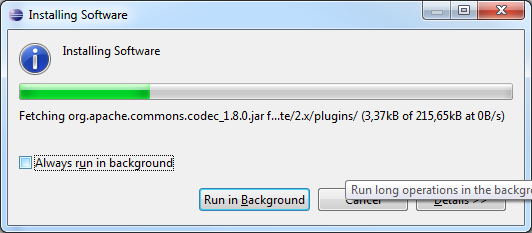


See Oracle Location-Independent Access to Resources Order to ensure location-independent access to resources: This is required by the Oracle Java Specification in In other words, the directory elements must not have any space characters (or non-Java identifierĬharacters) in any of the path elements.
APACHE DIRECTORY STUDIO FOR JAVA 9 FULL
Of the full absolute path of the target installation directory must qualify as Java identifiers. This component accesses resource files for testing.
APACHE DIRECTORY STUDIO FOR JAVA 9 CODE
Compile & test the library from source code using:.use the provided script for this purpose.Compile, test and create a Jar for a specific Java version.The second use case is for a Memory Component Developer and Contributor. The first is for a System Developer that needs to build and test their own Jar from source for a specific Java version. In this environment the developer needs to build the Memory component from source and run the Memory Component tests. Note: do not embed any spaces in the full argument. If you are not sure the extent of the Memory API being used, there is no harm in specifying all 4 JVM arguments. If any of the columns contain a Yes, then the JVM argument in the first column of the row containing a Yes will be required. Choose the columns that describe your use of the Memory API. If your application is a JPMS module use the following table.add-opens java.base/java.nio= ALL-UNNAMED If your application is not a JPMS module use the following table.Otherwise, if you are running Java 9-13 and. If you are running Java 9-13 and only using the Heap related API, no extra JVM arguments are required.If you are running Java 8, no extra JVM arguments are required.In this environment, the user is using the Jars from Maven Central as a library dependency and not attempting to build the Memory component from the source code or run the Memory component tests. USE AS A LIBRARY (using jars from Maven Central) The actual JVM arguments required will depend on how the user intends to use the Memory API, the Java version used to run the user's application and whether the user's application is a JPMS application or not.Īlso see the usage examples for more information. However, Java 9 introduced the Java Platform Module System (JPMS) where access to these internal classes requires starting up the JVM with special JPMS arguments. Providing access to the four contiguous byte resources (mentioned above) in Java 8 only requires reflection. Starting with release datasketches-memory-2.0.0, this Memory component supports Java 8 through Java 13. If you are interested in making contributions to this Memory component please see our

Please visit the main DataSketches website for more information. Memory-Mapped Files Contiguous bytes of a file represented in off-heap memory and created using, e.g., the WritableMemory.writableMap(File) method. For purposes of this document this includes on-heap ByteBuffers constructed using ByteBuffer.allocate(int).ĭirectByteBuffer: Contiguous bytes of a ByteBuffer constructed by, e.g., WritableMemory.writableWrap(ByteBuffer) where the ByteBuffer was previously constructed using ByteBuffer.allocateDirect(int) or, is a slice() thereof.ĭirect: Contiguous bytes off the Java Heap constructed by, e.g., WritableMemory.allocateDirect(long) method. Heap: Contiguous bytes on the Java Heap constructed by, e.g., WritableMemory.writableWrap(byte) or using the WritableMemory.allocate(int) method. Each of the four resource types is accessed using different API methods in the Memory component. The goal of this component of the DataSketches library is to provide a high performance access API for accessing four different types of memory resources. This Memory component is general purpose, has no external runtime dependencies and can be used in anyĪpplication that needs to manage data structures inside or outside the Java heap.


 0 kommentar(er)
0 kommentar(er)
